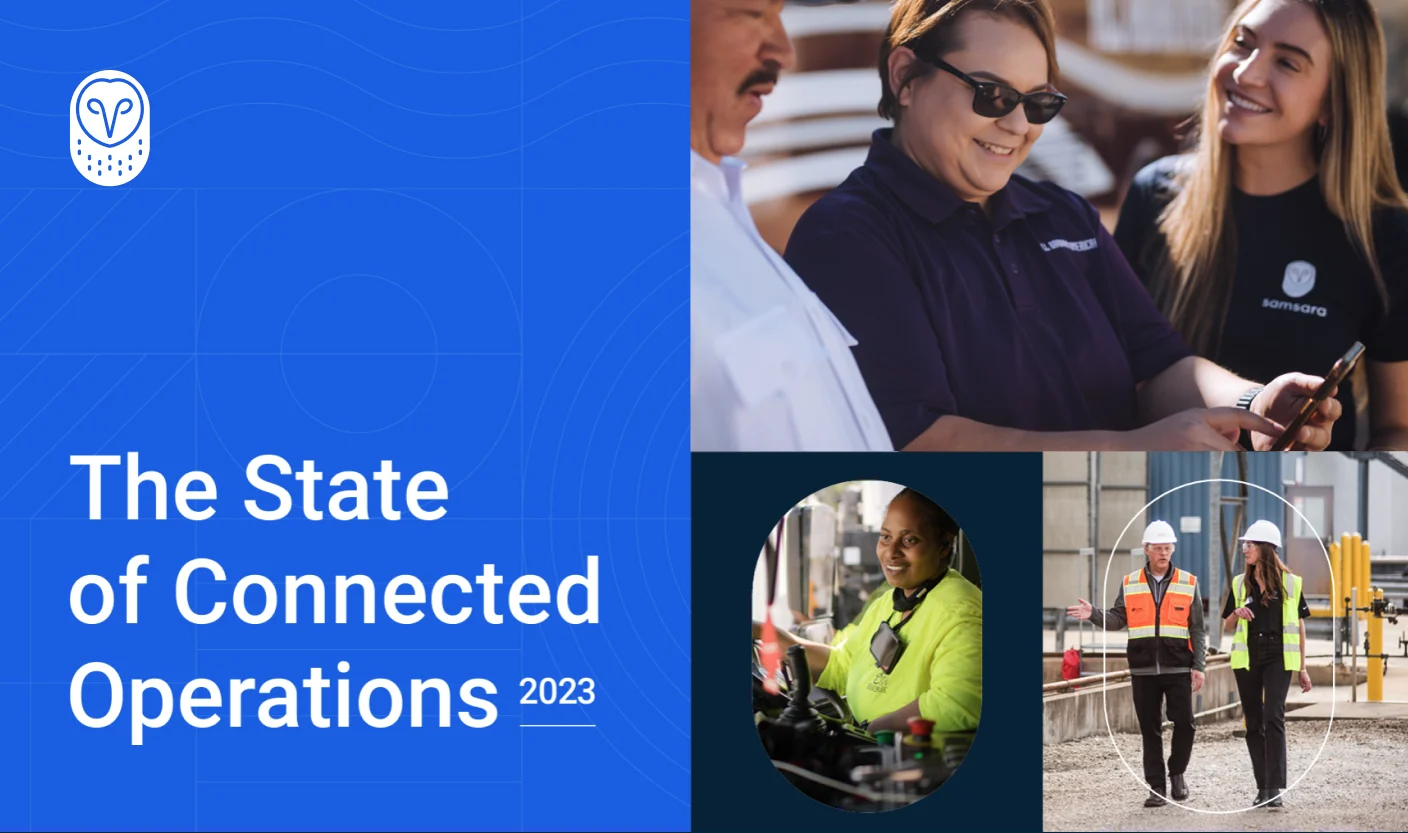How Many Workers’ Comp Claims Are Denied Each Year?
December 15, 2022

Get started with Samsara
Check our pricesKey Takeaways
In the United States, the total cost of disabling workplace injuries is more than $58 billion a year. Workers’ compensation insurance is the primary way that employers provide benefits to workers who are injured on the job. In this guide, you'll learn more about workers’ compensation, including common injuries that lead to workers’ comp claims and how many claims are denied each year, as well as how to use Samsara Site Visibility to prevent workplace injuries.
Over the last 50 years, government agencies and companies have worked together to create much safer workplaces. In fact, injuries and illness have dropped significantly in that time, declining from 10.9 cases per 100 full-time equivalent (FTE) workers in 1972, to just 2.8 incidents per 100 FTE workers in 2018, a 75% decrease.
Despite these huge gains, workplace injuries and illnesses are still common, and they can be costly for workers and employers alike. A recent study found that workplace injuries cost companies $1 billion a week.
The primary way that injured workers pay for medical treatment and other expenses is with workers' compensation insurance. In this guide, you'll learn about the most common work-related injuries associated with claims, how many workers compensation claims are denied, and how Site Visibility can help prevent injuries before they happen.
What is workers’ compensation?
Workers' compensation, commonly shortened to "workers' comp," is insurance that provides benefits to workers who get injured or become ill as a result of their jobs. Workers’ compensation benefits often include cash to replace lost wages, as well as pay for the cost of medical care and rehabilitation services, if needed.
In the U.S., workers’ compensation insurance is primarily administered by individual states, though there are programs managed by the U.S. Department of Labor for federal employees and certain groups, such as longshore and harbor workers. At the state level, individual employers are mandated to pay premiums to private insurers, who administer and pay out benefits. Texas is the only state that does not require employers to have workers' comp insurance.
Each state has an agency that oversees their workers' comp program, and claims requirements and benefits vary greatly by location. Called workers' compensation boards, these organizations ensure that employers provide the required coverage and intervene when disputes arise.
What are the most common injuries that lead to workers comp claims?
In 2019, the top 10 causes of serious, nonfatal workplace accidents amounted to $49.18 billion in direct workers' compensation costs. These are the top five types of workplace accidents and the total cost of workers’ comp claims for each:
Overexertion involving outside sources: This work injury occurs when employees lift, push, pull, carry, or throw objects, often when they are too heavy. These injuries cost $12.63 billion in workers' comp per year.
Falls on the same level: At job sites, trips and slips are more common—and costly—than falling off a roof or ladder. Falls on the same level-type injuries cost $10.26 billion in workers' comp every year.
Struck by an object or equipment: A tree that hits a logger, a construction worker that gets hit by debris from a collapsing wall—these are two examples of "struck-by" injuries. Objects or equipment that fall, roll, slip, and swing can pose a serious threat to workers, and they cost $5.66 billion per year in worker's comp.
Falls to a lower level: Even if falling from a ladder or roof isn't as common as tripping, the "falls to lower level" injury category is still a major cause of workers' comp claims, costing just over $5 billion per year.
Other exertions or bodily reactions: This category includes injuries that are caused by repetitive motion or awkward posture, such as crouching, crawling, lifting, or using tools that cause hand or muscle strain. These injuries lead to a little over $4 billion in workers' comp claims each year.
What percentage of workers’ comp claims are denied?
A workers' compensation case goes through a rigorous review process and insurance companies end up denying a significant portion of them. According to the most recent study with comprehensive data, 7% of workers' compensation claims are initially denied, though these percentages can vary by state. In Oregon for example, 12% of workers' comp claims are denied.
Here are some common reasons an insurance carrier will deny a workers' comp claim:
A missed filing deadline: To receive workers' comp, injuries must be reported to employers immediately, and workers must file a claim within a certain time period. These deadlines are detailed in workers’ compensation law and vary by state. For example, for California workers’ compensation, the deadline is 30 days, while Wisconsin gives workers six years from the date of injury to file a claim.
Disputes about whether an injury is work-related: If there is a dispute about whether an injury was actually caused by work—as opposed to misconduct, for example—an insurance company may deny a claim. Workers will need to present evidence, such as detailed medical records, that their injury is work-related. If an injury is determined to stem from a pre-existing condition, a claim may also be denied.
A condition doesn't meet guidelines: Some states may restrict the types of injuries and illnesses that workers can file claims before. For example, long-term emotional stress caused by work often does not qualify. To submit an injury claim, workers will usually be required to see a qualified medical evaluator (QME), a doctor who is certified to evaluate disability and write medical-legal reports.
A worker filed a claim after they left the job:Insurance companies will usually deny claims that are filed by workers who quit a job, were laid off, or were terminated. Some states have exceptions to these rules.
If a claim is denied, workers may appeal and many choose to work with a workers’ compensation attorney who specializes in this specialized area of law. Often, workers’ compensation lawyers will offer a free consultation to help denied workers understand their options for appealing a decision.
Workers can also appeal to the workers’ compensation appeals board (WCAB) in their state. These agencies handle a range of matters related to comp cases, including claim review and adjudication. This process starts when a worker files an application for adjudication of claim and opts to have neutral judges selected by the WCAB decide their case.
Workers who appeal a claim denial have a significant chance of approval. The same study cited above found that 67% of denied claims are converted to paid within a year. Moreover, the award amount for a converted claim is 55% higher than the original claim on average.
The average cost of a workers' comp claim is just over $41,000. For employers, the direct financial impact of a workers' comp claim is mainly felt in the form of increased insurance premiums. Insurers use complex formulas to determine premium increases based on type of injury, record of OSHA violations, business size and location, and other factors.
Beyond insurance premiums, there are a number of indirect costs related to workers' comp claims that employers may need to pay. These include:
Cost of work stoppage: Employers may incur the expense of stopped or slowed project due to worker absences because of injury.
Time and expense to hire and train new staff: Employers may need to find replacement workers and get them up to speed to cover for injured workers.
Overtime costs: If additional workers can't be hired, employers may need to pay overtime to existing employees to cover extra shifts or complete projects.
Administrative costs and other additional wages: Employers may need to cover administrative time spent by managers and safety personnel processing claims, and wages for injured workers that are not paid by insurance.
Learn how Samsara Site Visibility can help prevent injuries
An increasing number of physical operations companies are using technology to help make worksites safer while reducing workers' comp liability. Samsara Site Visibility, for example, is an AI-video safety solution that allows managers to access and review footage at any time from any location.
With Samsara, supervisors can ensure that employees are following safety rules and procedures, such as checking to see if workers are wearing proper personal protective equipment. Samsara's intelligent software can also provide proactive alerts for people entering dangerous or restricted zones, helping safety managers to prevent incidents.
If an incident does occur, Samsara's Site Visibility solution streamlines investigations, allowing managers to search for specific incidents more quickly and enabling easy sharing with insurance companies so workers can get the support they need faster. Samsara can also deliver significant cost savings: One customer, Aunt Millie's—a large baking company with more than 60 locations—has used Site Visibility to help prevent serious injuries before they happen and save the company a potential $1 million+ in injury claims.
If you're curious to know more about how Samsara can benefit your worksite safety, contact our team today to learn more or get a free trial.
Learn more about Site Visibility








